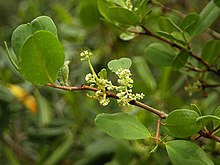Laguncularia racemosa
This article needs additional citations for verification. (August 2020) |
| Laguncularia racemosa | |
|---|---|

| |
| At Caeté estuary, Bragança, Pará, Brazil | |
| Scientific classification | |
| Kingdom: | Plantae |
| Clade: | Tracheophytes |
| Clade: | Angiosperms |
| Clade: | Eudicots |
| Clade: | Rosids |
| Order: | Myrtales |
| Family: | Combretaceae |
| Genus: | Laguncularia |
| Species: | L. racemosa
|
| Binomial name | |
| Laguncularia racemosa | |
| Synonyms | |
|
Conocarpus racemosa L. | |
Laguncularia racemosa, the white mangrove,[1] is a species of flowering plant in the leadwood tree family, Combretaceae. It is native to the coasts of western Africa from Senegal to Cameroon, the Atlantic Coast of the Americas from Bermuda and Florida to the Bahamas, Mexico, the Caribbean, and south to Brazil; and on the Pacific Coast of the Americas from Mexico to northwestern Peru, including the Galápagos Islands.[1]

It is a mangrove tree, growing to 12–18 m (39–59 ft) tall. The bark is gray-brown or reddish, and rough and fissured. Pneumatophores and/or prop roots may be present, depending on environmental conditions. The leaves are opposite, elliptical, 12–18 cm (4.7–7.1 in) long, and 2.5–5.0 cm (0.98–1.97 in) broad, rounded at both ends, entire, smooth, leathery in texture, slightly fleshy, without visible veins, and yellow-green in color. The petiole is stout, reddish, and 10–13 mm (0.39–0.51 in) long, with two small glands near the blade that exude sugars. The white, bell-shaped flowers are mostly bisexual and about 5 mm (0.20 in) long. The fruit is a reddish-brown drupe, about 12–20 mm (0.47–0.79 in) long, with longitudinal ridges. The single seed is sometimes viviparous.
It grows in coastal areas of bays, lagoons, and tidal creeks, typically growing inland of other mangroves, well above the high tide line.
References[]
- ^ Jump up to: a b c Ellison, A.; Farnsworth, E. & Moore, G. (2010). "Laguncularia racemosa". IUCN Red List of Threatened Species. 2010: e.T178798A7609219. Retrieved 13 August 2020.
External links[]
| Wikimedia Commons has media related to Laguncularia racemosa. |
- San Diego Natural History Museum: Laguncularia recemosa
- Smithsonian Marine Station: Laguncularia recemosa
- Purdue University: Laguncularia recemosa
- IUCN Red List least concern species
- Combretaceae
- Mangroves
- Flora of Florida
- Flora of Mexico
- Flora of South America
- Myrtales stubs

